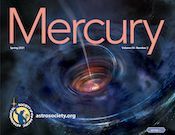Spring 2021 - Volume 50, Number 2

Table of Contents:
[19] Space News
A rundown of some of the most exciting developments in space and time.
[23] The Story of Black Holes
Once considered inconceivable, these invisible monsters are now known to be prevalent, fascinating, and influential.
[31] Pluto and Its Neighbors
Beyond Neptune is a band of small, rocky objects making up a surprisingly complex third zone to the Solar System.
[37] Our Mysterious Home
Discoveries over the past 50 years have revolutionized how we view the Milky Way Galaxy.
Departments:
[3] Perspectives, Liz Kruesi
Mercury’s Newest Column
[4] First Word, Linda Shore
Because There Is No “Planet B”
[6] Annals of Astronomy, Clifford J. Cunningham
Patron Saint of Astronomy at 800
[8] Faces of Astronomy, Liz Kruesi
Meet Edgard G. Rivera-Valentín
[11] Armchair Astrophysics, Christopher Wanjek
Blasts from the Past
[13] Education Matters, Brian Kruse
Think Cosmically, Act Globally
[15] A Little Learning, C. Renée James & Scott T. Miller
Navigating Unfamiliar Waters
[44] Reflections, Liz Kruesi
This Doughnut Launches Jets
************
The Story of Black Holes (Feature)
By Summer Ash
Black holes are no longer a mere astrophysical curiosity. They have gone from mathematical oddity to sci-fi staple to mainstream media darling. In fact, we now believe there are likely 100 million stellar-mass black holes in our galaxy alone and that every galaxy plays host to a supermassive black hole at its center. The discoveries of the past couple decades have ushered us into the golden era of black holes. How much do we actually know about these celestial beasts, and what do we have yet to learn.
Image credit (Spr21_feature1.jpg):
NASA/JPL-Caltech
Pluto and Its Neighbors (Feature)
By Nola Taylor Tillman
For decades, Pluto was thought to sail alone through the ocean of space, a lonely wanderer with only a single moon as a companion. In fact, Pluto was the first object spotted in a disk of icy material known as the Kuiper Belt. Starting at Neptune, the Kuiper Belt contains some of the most pristine material in the Solar System, its population essentially unchanged since the formation of the Solar System over four billion years ago.
Image credit (Spr21_feature2.jpg):
ESA
Our Mysterious Home (Feature)
By M. Katy Rodriguez Wimberly
From our cosmically tiny blue marble of a planet, the Milky Way appears merely as a bright strip of stars set against the darker night sky. Every human culture on Earth has seen, known, and wondered about this pathway in the sky. For many modern astronomers, we see it as our mysterious home — a vast astronomical laboratory where we can take incredibly detailed observations across the full range of light and the rest of the electromagnetic spectrum. From those data, we know details of the Milky Way’s structure and contents, our location within that structure, and even how the Milky Way came to be.
Image credit (Spr21_feature3.jpg):
ESO/José Francisco Salgado (josefrancisco.org)
